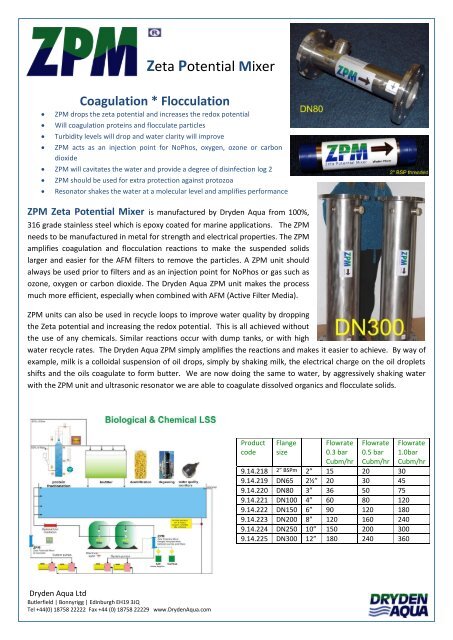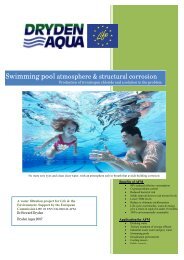Zeta Potential Mixer Coagulation * Flocculation - Dryden Aqua Ltd
Zeta Potential Mixer Coagulation * Flocculation - Dryden Aqua Ltd
Zeta Potential Mixer Coagulation * Flocculation - Dryden Aqua Ltd
You also want an ePaper? Increase the reach of your titles
YUMPU automatically turns print PDFs into web optimized ePapers that Google loves.
<strong>Zeta</strong> <strong>Potential</strong> <strong>Mixer</strong><br />
<strong>Coagulation</strong> * <strong>Flocculation</strong><br />
� ZPM drops the zeta potential and increases the redox potential<br />
� Will coagulation proteins and flocculate particles<br />
� Turbidity levels will drop and water clarity will improve<br />
� ZPM acts as an injection point for NoPhos, oxygen, ozone or carbon<br />
dioxide<br />
� ZPM will cavitates the water and provide a degree of disinfection log 2<br />
� ZPM should be used for extra protection against protozoa<br />
� Resonator shakes the water at a molecular level and amplifies performance<br />
ZPM <strong>Zeta</strong> <strong>Potential</strong> <strong>Mixer</strong> is manufactured by <strong>Dryden</strong> <strong>Aqua</strong> from 100%,<br />
316 grade stainless steel which is epoxy coated for marine applications. The ZPM<br />
needs to be manufactured in metal for strength and electrical properties. The ZPM<br />
amplifies coagulation and flocculation reactions to make the suspended solids<br />
larger and easier for the AFM filters to remove the particles. A ZPM unit should<br />
always be used prior to filters and as an injection point for NoPhos or gas such as<br />
ozone, oxygen or carbon dioxide. The <strong>Dryden</strong> <strong>Aqua</strong> ZPM unit makes the process<br />
much more efficient, especially when combined with AFM (Active Filter Media).<br />
ZPM units can also be used in recycle loops to improve water quality by dropping<br />
the <strong>Zeta</strong> potential and increasing the redox potential. This is all achieved without<br />
the use of any chemicals. Similar reactions occur with dump tanks, or with high<br />
water recycle rates. The <strong>Dryden</strong> <strong>Aqua</strong> ZPM simply amplifies the reactions and makes it easier to achieve. By way of<br />
example, milk is a colloidal suspension of oil drops, simply by shaking milk, the electrical charge on the oil droplets<br />
shifts and the oils coagulate to form butter. We are now doing the same to water, by aggressively shaking water<br />
with the ZPM unit and ultrasonic resonator we are able to coagulate dissolved organics and flocculate solids.<br />
<strong>Dryden</strong> <strong>Aqua</strong> <strong>Ltd</strong><br />
Butlerfield | Bonnyrigg | Edinburgh EH19 3JQ<br />
Tel +44(0) 18758 22222 Fax +44 (0) 18758 22229 www.<strong>Dryden</strong><strong>Aqua</strong>.com<br />
Product<br />
code<br />
Flange<br />
size<br />
Flowrate<br />
0.3 bar<br />
Cubm/hr<br />
Flowrate<br />
0.5 bar<br />
Cubm/hr<br />
9.14.218 2” BSPm 2” 15 20 30<br />
9.14.219 DN65 2½” 20 30 45<br />
9.14.220 DN80 3” 36 50 75<br />
9.14.221 DN100 4” 60 80 120<br />
9.14.222 DN150 6” 90 120 180<br />
9.14.223 DN200 8” 120 160 240<br />
9.14.224 DN250 10” 150 200 300<br />
9.14.225 DN300 12” 180 240 360<br />
Flowrate<br />
1.0bar<br />
Cubm/hr
Resonator for ZPM<br />
The resonator fits into the female threaded socket in the <strong>Dryden</strong> <strong>Aqua</strong> ZPM<br />
The resonator is a high frequency very powerful transducer that shakes the<br />
water at a molecular level. The frequency and power of the resonator<br />
generates nano-bubbles by extreme cavitation, the bubbles are further subdivided<br />
by the cavitation action of the ZPM.<br />
Nano bubble have a high degree of stability and are attracted to the surface of<br />
particles such as viruses, bacteria, fungal spores and protozoa or the surface of<br />
organic molecules. On touching a solid surface the nano-bubbles collapse to<br />
release energy directly onto the cell membranes. This has the effect of<br />
disinfecting the water without the use of chemicals. When a nano-bubble<br />
collapses on an organic molecule, the energy released will oxidise the molecule.<br />
Any nano-bubbles that do not collapse will auto destruct after a few seconds.<br />
ACO (active catalytic oxidation) product is injected into the ZPM unit, the nano<br />
particles of titanium dioxide react with the nano-bubbles from the resonator.<br />
The ACO acts as a catalysts powered up by the resonator to dissociate water<br />
molecules into super oxides and hydroxyl radicals. These free radicals are also<br />
very short lived, but they will oxidise dissolved organics and help to disinfect the<br />
water. ACO is now being used to replace kaolin in marine hatcheries for the<br />
cultivation of cod and halibut to provide a degree of disinfection during the early<br />
rearing stages<br />
ACO also helps to shift the zeta potential of the water to a high negative state<br />
which drops the surface tension and makes to make it extremely difficult for<br />
bacteria to survive. The system has changed the way water molecules relate to<br />
each other, also referred to as the hydrogen bonding. The water remains in this<br />
state for many hours and sometime days and will continue to self disinfect.<br />
NoPhos acts both as a flocculent and phosphate precipitating agent.<br />
NoPhos, it is a very effective flocculent and as such it will bring micron and submicron<br />
particles in suspension together to make them much larger, thereby<br />
allowing the pressure AFM filters to remove very fine solids. NoPhos should always<br />
be used with AFM® filter media in the sand filters because it works synergistically<br />
with NoPhos. In effect the NoPhos places a positive charge on the particles and<br />
AFM® removes the small particles by electrical attraction. In addition, if too much<br />
NoPhos is used, the AFM® will adsorb the excess NoPhos.<br />
NoPhos reacts with soluble reactive phosphate to form and insoluble precipitate, the<br />
reaction is stoichiometric (see equation below). By carefully controlling the<br />
phosphate level you can control the growth of plants and algae. If an aquarium has<br />
a high turbidity caused by algae, then NoPhos can be used to reduce the phosphate<br />
food source and gradually over a period of a few weeks reduce the algae levels.<br />
Phosphate is also required by bacteria, so if a large dose of NoPhos is used then<br />
bacteria will be prevented from growing. In an aquarium system this is not desired<br />
because the biological filter would fail and the corals would suffer.<br />
<strong>Dryden</strong> <strong>Aqua</strong> <strong>Ltd</strong><br />
Butlerfield | Bonnyrigg | Edinburgh EH19 3JQ<br />
Tel +44(0) 18758 22222 Fax +44 (0) 18758 22229 www.<strong>Dryden</strong><strong>Aqua</strong>.com<br />
NoPhos + PO4 -3 = NoPhos PO4 (s)<br />
eelectron<br />
O- OH-<br />
dissolved organic matter<br />
& bacteria etc<br />
1kg of NoPhos will remove approximately 100g of Phosphate as PO4 - P or 300g of phosphate as PO4<br />
Light or ZPMr<br />
sunlight, out-doors<br />
through windows or even<br />
florescent lights & Uvc irradiation systems<br />
ACO ACO ACO ACO<br />
light wavelength increased energy released in the form of an electron<br />
h+<br />
catalytic photo reduction of water & oxygen electron hole<br />
on the surface of ACO forms hydroxyl radicals<br />
and super oxides for oxidation<br />
oxidation<br />
Co2 H20 N2






